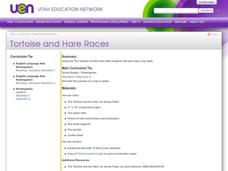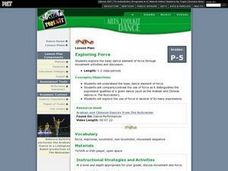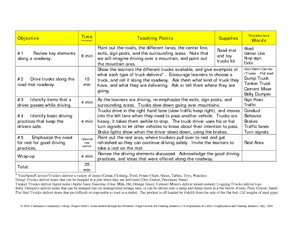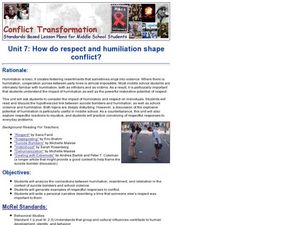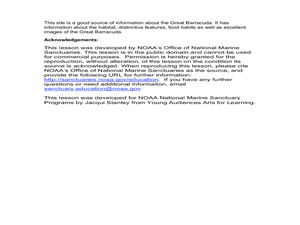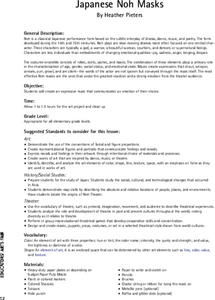Curated OER
Lights! Cameras! Action!: Creating a Drama About the Lyme Art Colony
Discuss the lives of artists in the Lyme Art Colony in the 1900s with this resource. Young historians write and perform a short scene depicting individuals who lived in the Griswold boardinghouse, used by the colony artists. They use the...
Curated OER
Paper Maché Mancala Game Boards
Seventh graders create three dimensional works of art from two dimensional plans, develop skills in papier-mach?? technique, utilize elements and principles of design to create 3-D form, and develop math/strategy skills in playing the...
Curated OER
Tortoise and Hare Races
Practice basic map skills with the story of The Tortoise and the Hare. After listening to the story, class members create a map that indicates the starting line, the path the animals took, where they stopped to rest, and the finish line....
Curated OER
Dancing through Poetry
Get your class up and moving as they explore how to express movement and dance through words. Designed around two poems by Lillian Morrison about break dancing, the activity truly captures the creative and multi-sensory aspects of...
Curated OER
Exploring Force: The Nutcracker
Students explore basic dance element of force, compare and contrast the use of force as it distinguishes the expressive qualities of a given dance, and explore the use of force in several of its many expressions.
Curated OER
To Freeze or Not to Freeze
Young scholars examine the non-verbal elements of a theatrical performance. They read an article, answer discussion questions, conduct Internet research, and stage frozen tableaux based on lines from Shakespeare's works.
Curated OER
Starting at the Beginning
Sixth graders develop basic band skills through in-class instruction, individual practice, and the Essential Elements band method. Instruction is teacher-led with examples and drill/practice. National Standards for the arts are...
Curated OER
Body Movement
Second graders interpret and transform drawn lines into locomotive movements. In this improvised movement lesson, 2nd graders draw a line on a piece of paper and use the elements of dance to interpret and transform their draw line into...
Curated OER
You Too Can Haiku: How to Write a Haiku
Students explore language arts by writing their own poems. For this haiku lesson, students investigate the Japanese culture and their beautiful music, poetry and art. Students count the syllables in every line of a haiku poem and write...
Curated OER
Beyond the Notes
Learners observe as the teacher introduced themself as a talent scout for a clothing company for teenagers who is looking for a choreographer for a commercial for a new line of clothes called, "The Wrap". They work alone or in groups of...
Curated OER
Tempest in the Lunchroom
Students act out opening shipwreck scene of The Tempest, or watch and direct others doing it.
Curated OER
The Middle East Peace Process: Israeli and Palestinian Negotiations
Young scholars demonstrate the complexity of the Middle East peace processand develop their negotiation skills. They role-play as negotiators for Israel and the PLO attempting to resolve four major issues.
Curated OER
Planet Dance
High schoolers examine Anna Halprin's philosophies and choreography and perform one of her Planet Dances. They find a site that inspires them to create a dance based on the environment's design, levels, textures, and atmosphere.
Curated OER
"I am Not Well": Unspoken Endings and Unscripted Scenes
Students analyze Act 4, scene 1 from the play, Merchant of Venice. They hypothesize the content of an unscripted moment and response, look for evidence in the text to support their hypothesis, rewrite the scene, and perform it for the...
Curated OER
Heaven or Ground Hog Day?
Students discover the ideas of enlightenment by reading historical poetry. In this philosophical lesson, students read poems by Sir Walter Scott and Sergeant Joyce Kilmer while discussing the themes of the writing with classmates....
Curated OER
Border Teatro
Learners analyze elements unique to the Chicano art form of the teatro (theater) and examine history connected to the form, namely the farm workers' movement of the 1960's.
Curated OER
Dancing Hands, Abstract Drawings
Students discover African musical rhythms by performing Ancestral Spirit Dances. In this musical lesson, students research Willis "Bing" Davis and the abstract work he created. Students listen to Yoruba drum music and...
Curated OER
Trucks on the Roadway
Young scholars explore trucks. In this truck and road safety lesson, students identify different types of trucks and define traffic and truck vocabulary. Young scholars manipulate toy trucks on a road floor mat.
Curated OER
Lesson Plan for Adagio for Strings, Op. 11 (1938)
Students study the life and music of composer, Samuel Barber. In groups, representing trees, water, and stars they use interpretive dance to tell the story of the musical composition, 'Adagio for Strings, Op. 11' by Barber.
Curated OER
How Do Respect and Humiliation Shape Conflict?
Students explore the feelings surrounded by humiliation, resentment and retaliation in the context of school violence. In this character building lesson, students examine possible reasons for school violence and focus on possible...
Curated OER
Traveling Through the Digestive System
Second graders learn about how the food is broken down in our bodies and the job of each body part involved in our digestive system. The utilize the CD ROM game, "Body Works." This wonderful game takes pupils through the human body's...
Curated OER
The Great Barracuda
Students explore oceanography by researching the great barracuda. In this animal life lesson, students read several vocabulary terms dealing with ocean life and examine a drawing of a barracuda. Students examine the many...
Curated OER
Yut, a Traditional Korean Game
Students play a Parcheesi type game. They explore a new culture, to compare and contrast likenesses and differences in American and Korean families and leisure time and to experience a traditional Korean game. They identify where...
Curated OER
Japanese Noh Masks
Students examine Japanese theatre and create their own face masks which display certain emotions, props, costumes and perform in improvisational theatrical games.


